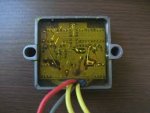96' 75hp Force. When I put my meter on the battery it reads about 12.8V... I will also put out the disclaimer its a cheap Multimeter, but I think it gets me close. When I start the boat up and I stick the meter on it, the Voltage jumps. It will stay about about 13.5-14v for a second then drop to 9 then 1 then right back to 13... My reading on my dash doesn't jump around.. it seems to stay around 13.5v....
I recently changed my Voltage Regulator/Rectifier.... when I shut the engine off it ready 12.8v with no jumping around... Is this something wit my meter? Bad regulator? I can't imagine my battery voltage drops to 1v then immediately back to 13.
I recently changed my Voltage Regulator/Rectifier.... when I shut the engine off it ready 12.8v with no jumping around... Is this something wit my meter? Bad regulator? I can't imagine my battery voltage drops to 1v then immediately back to 13.




















